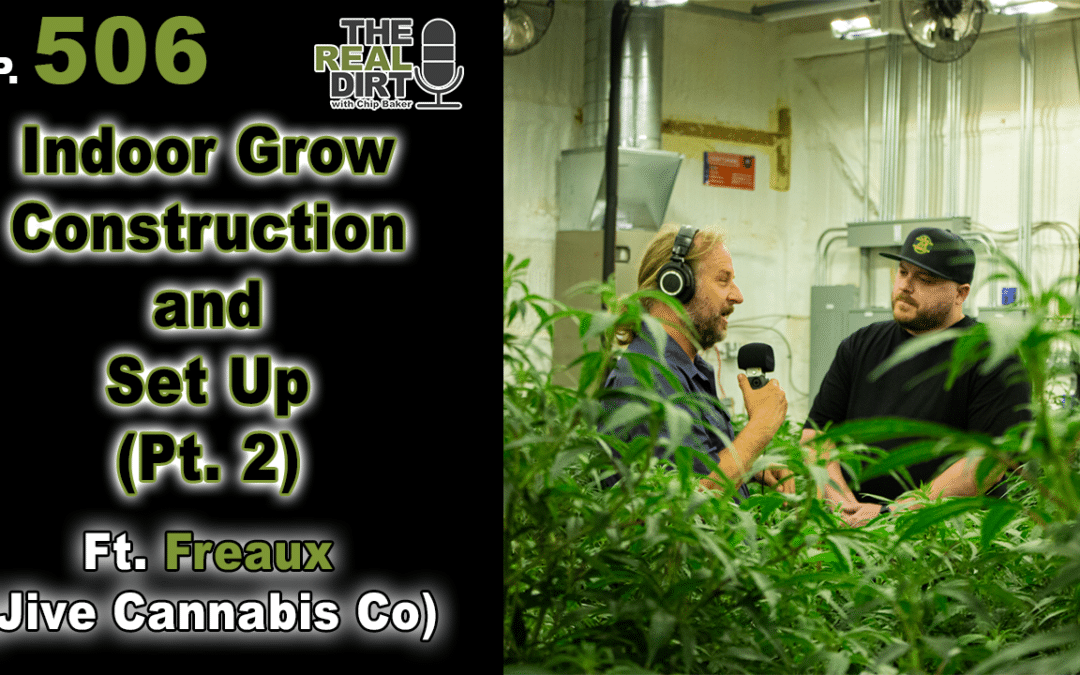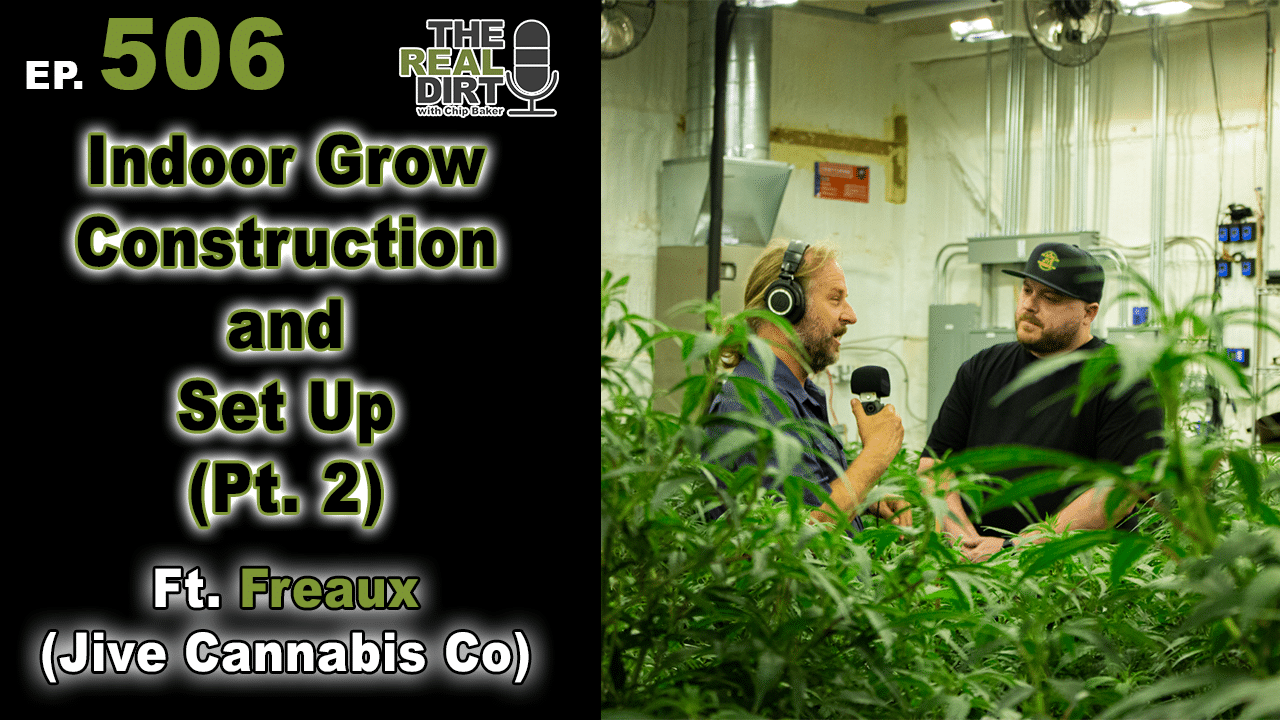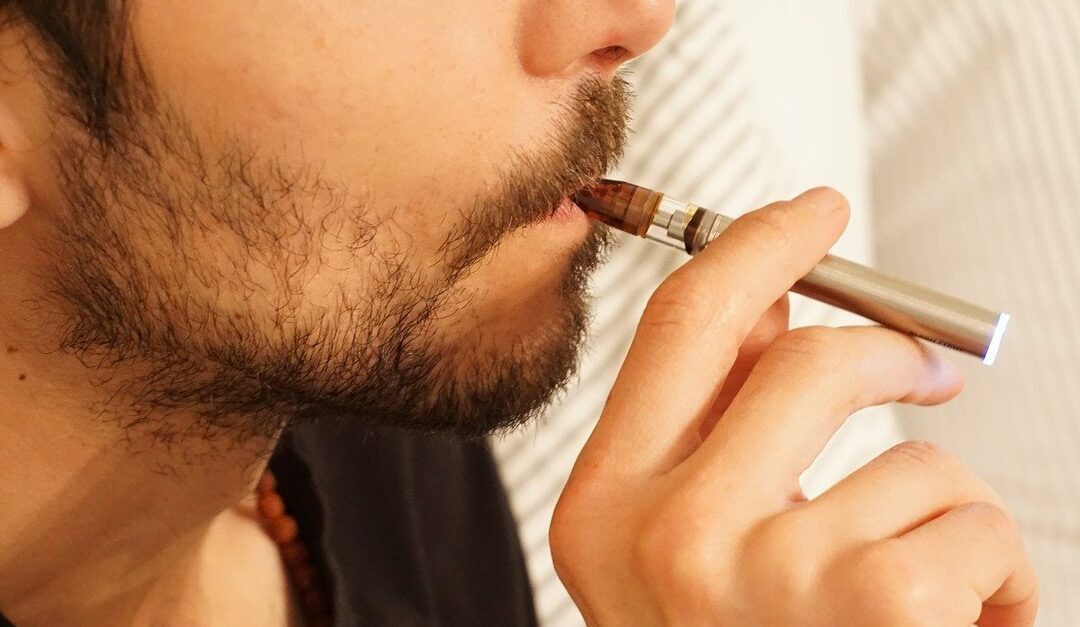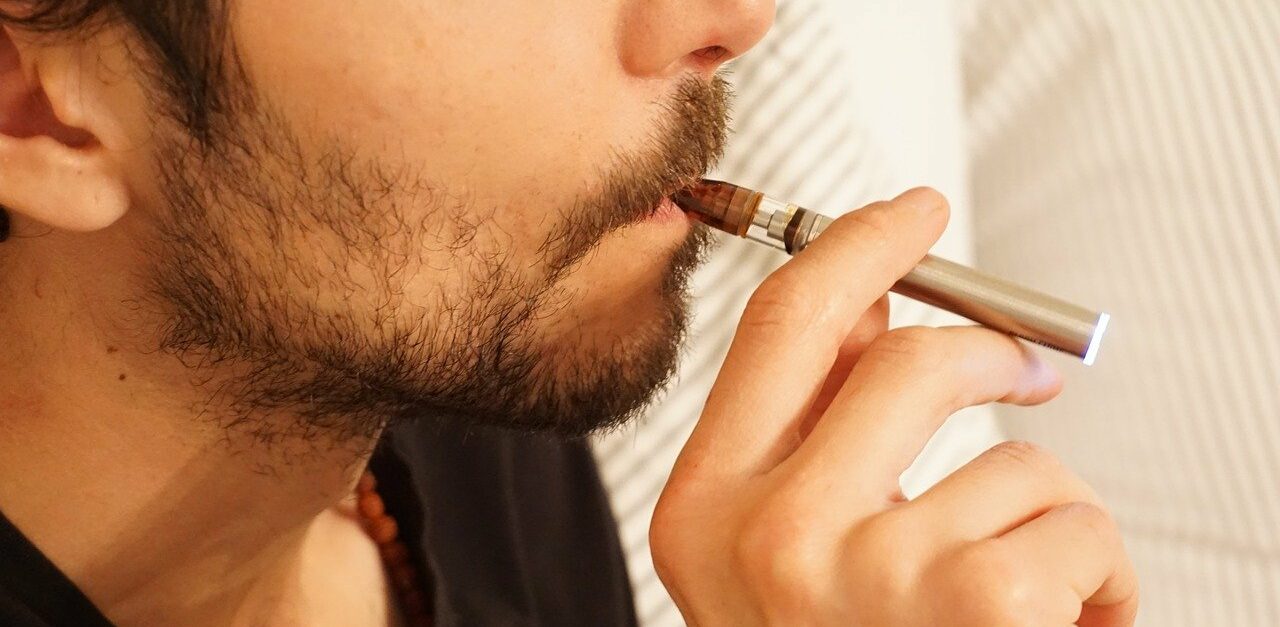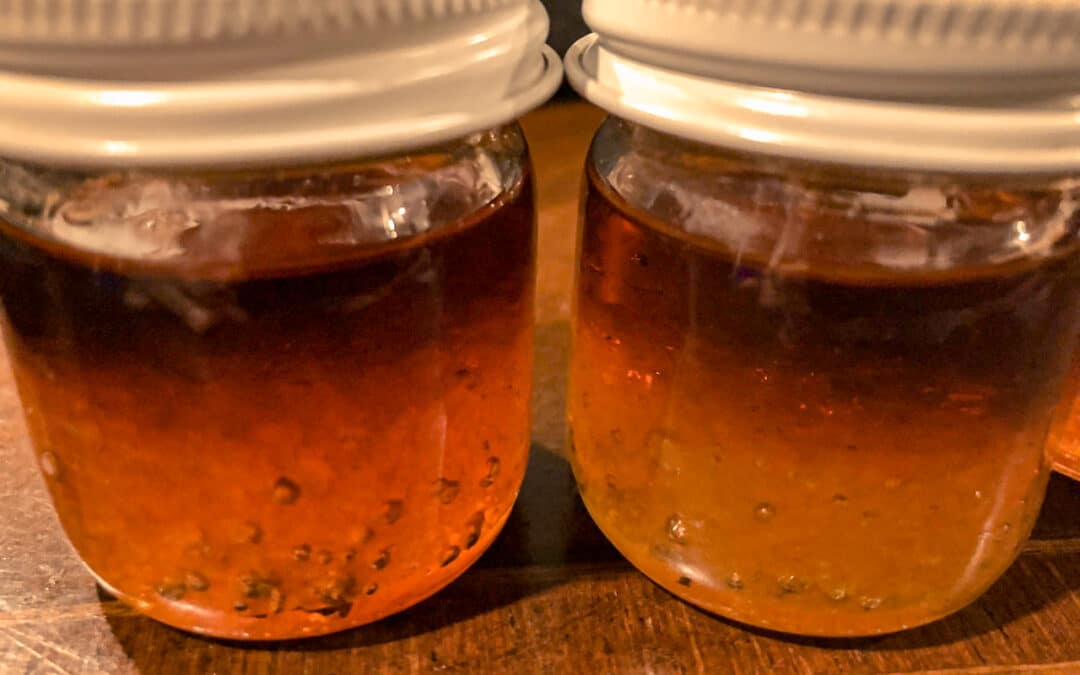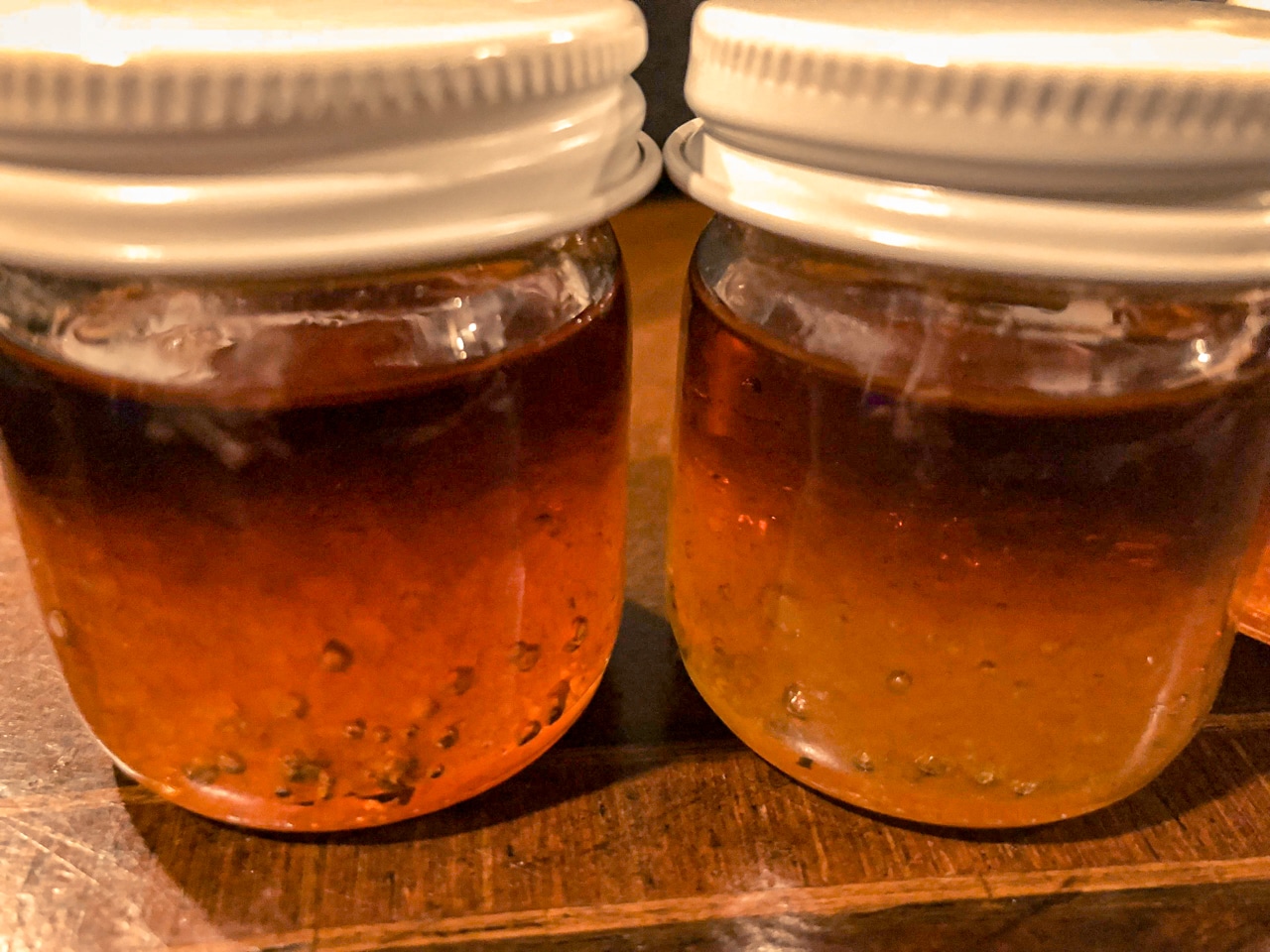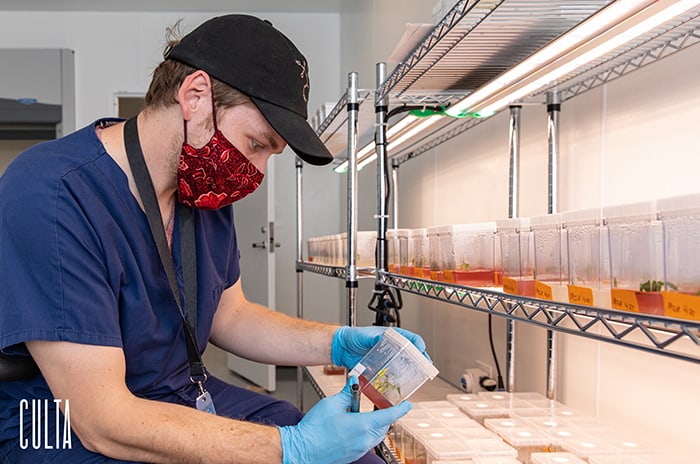![The Real Dirt on Growing with Salts [Front Row Pt. 1]](https://therealdirt.com/wp-content/uploads/2021/07/Ep507Thumbnail-1080x675.png)
The Real Dirt on Growing with Salts [Front Row Pt. 1]
Podcast: Play in new window | Embed
Subscribe: Google Podcasts | Spotify | iHeartRadio | Stitcher | Email | TuneIn | RSS
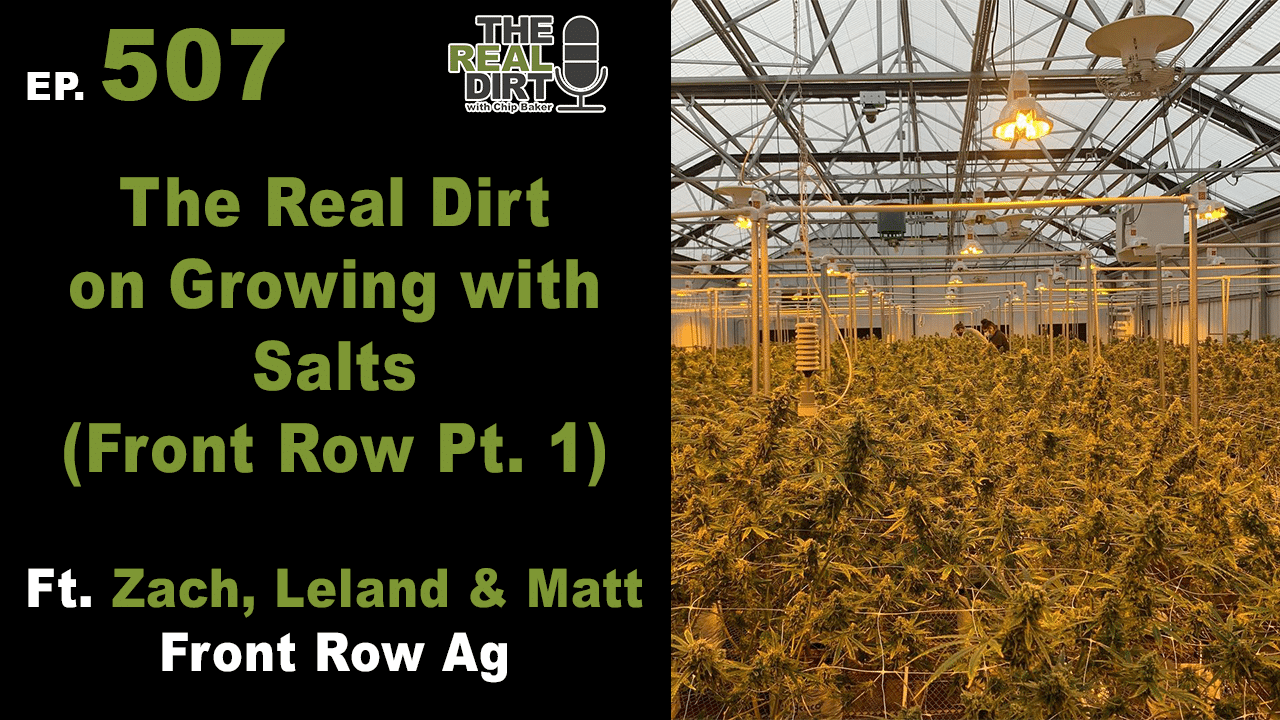
Powder nutrients, liquid nutrients, salts….what’s the difference? Probably not as much as you might think.
There’s no shortage of controversial debates among cannabis growers:
- Organic vs Synthetic Nutrients
- Indoor vs Outdoor Cultivation
- LED vs HPS Lighting
- Hand Watering vs Irrigation
And the list goes on…
But a debate that has become more popular recently is one with a lot of misconceptions, and that debate is growing with salts vs anything else.
What are Salts?
Just like the word “organics” can cover a wide range of nutrients, micronutrients and other inputs, the word “salts” covers a wide range of naturally or synthetically derived minerals that are beneficial to cannabis cultivation. The name comes from the consistency of the product which can look like coarse or rounded salt.
The real difference between salts and liquid nutrients is, well, the liquid. That’s about it really.
Liquid nutrients are more or less salts that have been dissolved or mixed with water and bottled. In other words liquid nutrients are diluted salts.
For most salts and liquid nutrients, that’s where the differences end. So if that’s the case, which should you choose?
Front Row Ag and the benefits of Salts
Front Row Ag is a small-team nutrient company that created a 3-part line of salts that is easy to use, leading a lot of growers to make the switch from liquid nutrients. From application to impact, the difference with Front Row Ag nutrients is clear.
In Part 1 of The Real Dirt ft. Zach, Leland and Matt from Front Row Ag, Chip and the guys start scratching the surface of why Front Row went with a synthetic salt product, how they have become so popular over the last couple of years, the right and wrong ways to mix a reservoir and more.
Transcript
Chip: Hey welcome once again to another fabulous episode of The Real Dirt. And today, it’s The Real Dirt with Front Row Ag. Hey man, you know, we sell tons of different products at Cultivate Colorado, Cultivate OKC. Hey look, there’s somebody wanting to buy some products right now. Front Row Ag is one of our more popular dry soluble products. Man today I’ve got Matt: Zealand. It’s a team of Zach and Leland together, the sales team, the technical support team Zealand. No, Zach and Leland and Matt. These guys, Matt’s the product formulator for the company, Zach and Leland, they’re the product technical support sales staff. And man, we’re really excited about this product. At Cultivate Colorado, Cultivate OKC, we have turned so many commercial and home growers onto this. It is such a great and easy product to use. And hey, man, thanks for you guys showing up here today.
Front Row: Appreciate it. Thanks for having us.
Chip: Alright. So yeah, man, what do we got here? Let’s uh, what kind of weeds did you guys bring? This import you got here? What’s, what’s going on? I hadn’t seen any other [inaudible 1:33] doughnuts. Did you, did you have any donuts
Zach: I had some donut.
Chip: Yeah, that’s gonna be my new Oklahoma strain called Donut.
Zach: Donuts?
Matt: Coffee and donuts.
Chip: Coffee and donuts, because most people don’t, people don’t understand Oklahoma’s known for many things. Donut shops, independent donut shops all over Oklahoma. Massage parlors, and now, cannabis dispensaries. They’re everywhere. On every block in every corner, you’ll see those three things.
Matt: Interesting.
Chip: And I’ll tell you, but I tell you what’s hard to find though, is weed that smells this good. Man, this is really, really, really great looking smelling ganja. Mmm, you know, I usually don’t smoke on my show. But I’m gonna ask you to pass a paper and a grinder over here and we’ll put it together.
Matt: You got it. It’s an honor.
Chip: So yeah, Front Row, man. These guys have brought a great product to the market. It is market driven, what customers want, what commercial gardeners want. And today, we’re gonna tell you everything about it. And man, I’m just gonna go ahead and preface this, these guys did not pay at all for the advertisement on this. But this will be very much like an infomercial, because we’re gonna tell you exactly how to use this product or all of their products. A and B Bloom SI Bio – is it bioflow?
Leland: Bioflow.
Chip: Bioflow and Unleash. We’re gonna give you the technical details for outdoor, indoor greenhouse, in the ground, pots, drip, sprinklers. So sit back, roll the largest joint you can and join us for this episode of The Real Dirt. Alright, Zach: tell us about Front Row Ag, how you started and where we are today.
Zach: So we started with Front Row Ag approximately two years ago, the product was developed by Matt: Karen, somewhere about seven years ago.
Matt: Still can’t say my last name.
Leland: Yeah, started yeah, we started the product about five years ago. And I met Zach and the guys two years ago.
Zach: Yep. So around two years ago, my business partner Patrick and I took over distribution of the products pretty much worldwide. And here we are today in Oklahoma, a few years later.
Chip: Oklahoma clap.
Zach: Oklahoma. There we go.
Chip: You know, Matt, you said you’d been working on this project for a number of years. You’re, you’re in Michigan, is that right?
Matt: No, I live in Northern Phoenix.
Chip: You’re in, you’re in Arizona?
Matt: Yep. Started growing in Colorado back in 2008, 2009 in Fort Collins and Loveland area. And then I’ve been cultivating for the better part of 10 or 11 years. And five years ago, you know, really had the idea for making the fertilizer well before that, but love growing. It’s really what I, what my passion was and always wanted to do. And so I stayed out of sales and making products and doing that business. At a certain point we saw a really, really high need for saving people money delivering a quality formulation. And so we just started making the idea a reality.
Chip: Man so, you know, I’m always interested in that business spark and what brought you to it. What were, what was kind of like the key reason that you wanted to develop this, this type of dry fertilizer product that’s for the cannabis industry?
Matt: Well, from a community perspective, just saving people money and not taking advantage of them. With [inaudible 5:14], the straw that broke the camel’s back for me and deciding to start dedicating less time to cultivation management, consulting for other people’s businesses and making a fertilizer, was making fertilizer buy from scratch for five, five acre outdoor farm, and burning it, burning it down as a result of making the fertilizer wrong. And saying, “Well, if it’s as easy as picking up the wrong bag with the same font and letters and colors, and you can ruin millions of dollars worth of weed, it should be a lot easier than that. But you shouldn’t be forced to go to go and spend exuberant amount of amounts of money to make that happen either.” And so we decided we’re gonna start Front Row.
Chip: So you know, many people they say this term like, all the time. “I’m on salts, I’m on salts, I’m on salts.” But it’s really like not exactly what’s going on, right? Like, what they mean is they’re on a dry soluble powder. Tell us kind of like, the difference between, you know, a cheap commercial like, cucumber fertilizer and Front Row.
Matt: The quality of the inputs on any good agricultural fertilizer, you’re going to have a grade. And that grade is you know how well they filtered it, how many contaminants and other things that are going to be in it that you don’t expect. And then, there’s just the quality of the inputs, certain fertilizers are more soluble and less, less soluble than others. And generally, the more soluble they are, and most cases they’re a better quality, but also more expensive. So a lot of companies can make choices to cut corners and still get you fertilizer in a bottle, but that they just use cheaper and lower quality inputs.
Chip: One of the things that y’alls customers say and Leland, this probably a great like question for you is ike, how much easier it’s kind of made their lives from using like a 14-part based formula. Because many of these people come from an indoor environment, an inside environment, and now they’re scaling, right?
Leland: Yeah, definitely. We see a lot of people who are super happy with the transitions. I mean, it’s a pretty simple transition overall, there’s nothing to really be concerned about in terms of making the switch onto the salts. That being said, as far as the ease of use, it’s literally a three part blend is what you’re using most of the time. Now we’re nixing out all the Cal mag, any extra micronutrients that you might be adding, and just kind of rolling with an A and a B blend through veg, adding a bloom amendments, so basically a PK booster when you get in the flower. So it’s really, really simple to use. It’s even simpler when we mess the stock on straight, which we’ll get into later. But um, yeah, I got a lot of guys who open their bags, and they’ll either be pre-weighing it, so they can just add it right into a reservoir right away and not have to be messing with the scale. Or, they’re just dissolving it right away into warm water and adding into the reservoir, which compared to mixing multiple bottles, they’re trying to pay attention to weighing anything out exactly, it makes it a lot more streamlined.
Chip: Man I’m sorry, I’m smoking this joint. It’s taste so good. I didn’t hear anything you just said.
Leland: I’m glad you’re enjoying it.
Chip: What were we, what were we talking about?
Front Row Nothing. Just water, man.
Chip: No, it’s true. And you know, one of the misnomers that maybe non-cannabis industry people don’t realize is that it’s not all the same, right? That those big chunky salts that happened to be in you know, the cucumber food or in their tomato food, or you know that they get at their local feed and seed for 15 bucks for 20 pounds, it’s nothing like this product. Most because it’s the micronutrient. Hey Matt:, let’s, let’s talk about the micronutrients in your product and how it is different from, from, say, you know, I don’t know Jack’s, or Peters, or something like that.
Matt: Well, I think on the micro side, when you start there with say calcium, magnesium is probably the biggest difference in our product, before we get into the the metals. But a lot of other products out in the market just from inclusion standpoint, you find two things, they either try to put too many products, ingredients are in one products. And then they can’t fit enough of the magnesium, the calcium in that bag. And so you end up buying a different additive or a different product they make. Or the industry throughout time has created such an importance on Piquet’s, calcium, magnesium, that they’ve made a belief almost that they have to come in separate bottles and you have to use them in addition. But really it’s just clever marketing or you know, preying on what people have been told over, and over, and over, versus our product because we separate out all the micronutrients and all the calcium into one product. We have a really high inclusion rate of magnesium and calcium, and you don’t have to go buy another product for that. And it’s, makes our product even easier to use as well.
Chip: So you know, this is, the history of cannabis fertilizer is really fascinating to me, because you know, there’s this long agricultural history that’s associated with, with dry products that you mix in a large stock reservoir. You’re shipping around this dry product, but then at some point, I mean, Joe Hydro did this. And you know, did it for all of us, and it was great to some degree in the hydro industry, is they made these products in a liquid form, right? In the 70s, and, you know, that’s when they came out with this first three part 1976 or something like that. Like, that’s products been going on a long time. And y’alls technologies literally liked, developed 40 years later, or something, 30 years later. So you know, you think there’s a considerable amount of technological advancements that have happened in that time. There has been, but in our industry, it’s almost all until now been liquid-oriented, right? Like, you guys got any, I mean as salespeople, you guys got any theories on why we kept a hold of the liquid fertilizers for such a long time?
Zach: I mean, I can speculate. I’ve been selling fertilizers, going into my 13th year, I started with Advanced Nutrients. So that’ll tell you back in the day, you know, selling the liquids and I would say at some level, you know, prior to that, Advanced Nutrients, actually one of their first products was all powder. You can go back and still look at GH, and you can see like even Maxi and all these other products that are still high-selling products in the market. I think that at one point what happened was, it was turned, it turned out to be like an ease of use thing. You know, it’s a hell of a lot easier. Most of the time to measure our mLs compared to grams, people mess that shit up all the time. But you think as –
Chip: They took out liquid mLs.
Zach: Yeah, liquid mLs compare, you know, you’d figure people by then would already figure out how to use some scales.
Matt: Especially the small scale too. One of those, you know, one light, two lights, or four lights?
Chip: Yeah, I mean, it’s two lighters. The two light guys definitely got a scale.
Matt: I think at that level too, the cost don’t matter as much. It’s, you know, you’re a hobbyist and, and the amount that you’re probably going to get per gram or per pound, it’s going to be exuberant. And you’re not as concerned about the liquid fertilizer?
Zach: Yeah, there’s an, I think at some level too, it was one thing and I always like to put throw this out there too, especially when I’m talking to a larger scale of people that can see like, what’s going on in say, one of the hydro stores and they look at all the bottles. Me personally, I felt blessed to work for Advanced early on with all those bottles because you know, if you look back over 10 years ago, when Big Mike’s split up all those bottles, he taught a lot of growers how to grow. Like most guys, they had all these products in two or three, four bottles. Let’s say five bottles total.
Chip: Oh yeah.
Zach: Well, he split them up. And yeah, it was a brilliant marketing idea. And it’s the reason why people can even sell liquid fertilizer at the price they do, is because of Big Mike but he split everything up. So people actually had to learn, “Oh, I’m, I’m deficient here or something else is going on here.” So in return, here’s another bottle yes, but here’s why you’re using this, and let me tell you all about it. So it was, it was genius in multiple ways but.
Chip: Yeah, you know, there’s lots of bad feelings or emotions over Advanced Nutrients. But man, I’m gonna tell you what Big Mike really did for us, is he was the first company who’s like, “We’re growing weed bitches.” Right? Like, “This is for weed. This is the two pound plus formula.” Remember that?
Zach: Dude, when I used to walk into a hydro store, I’m -no bullshit. If I start talking Advanced Nutrients, they’re like, “Hey, man, we got to keep us on the down” I looked at him. I’d be like, “You don’t get my products.” I’m lying. I’m like, “I’m here to teach you how to do this.”
Chip: Yeah, absolutely. Lots of people hated on those guys. And you know, man, honestly, I think they were hated on because they were so successful. And they were pioneers in the industry in so many ways. I mean, they pioneered the ultra expensive supplement, right? I mean, oh my god, they were the first people to have the most expensive supplements.
Leland: They made it fun too.
Chip: They made it fun, yeah.
Leland: And I think that was the real draw to liquid nutrients, was that there was like, you know, if I add this, I might get better results than I did last time. If you keep doing that and getting different results, like –
Chip: Everybody’s got something different to do. I get to be involved with my plant.
Leland: The difference between adding humic acids or adding a, you know, like guanos or just running a product with nothing added to it like, and seeing the nuances that can develop, whether it’s from those products or not, you know, it might just be all placebo, but it works. I mean, it’s definitely a consumer experience to be adding those new things and seeing what’s around the corner.
Zach: That’s a progression thing.
Leland: I apologize.
Zach: No go ahead, that’s kind of a progression thing, too, is like you know, somebody starts off with all these bottles, which is not a bad idea. And then they progress into hopefully they’ll land when they become pros at Front Row. So it’s like they can either become a be like, be a pro. But what’s really cool about our product too, is it’s extremely simplified to where somebody that is using those 15 bottles can understand, “Holy shit, I can use three.”
Matt: Well a lot of growers do as they as they scale up. Even like myself from a couple [inaudible 14:58] to barns, to warehouses, to commercial grows. You have those bottles and you realize well, “I’m probably gonna end up using them all in about the same way throughout the edge, and the same way throughout flower every single time.” And it really doesn’t need to be this complicated or at least have this many steps to the process every single time. I mean originally back in 2010 and ’11, that’s when we’re either using Advanced Nutrients or like, even Neutraplus with a bunch of bags of salt or botanic airs like, why are we, why we went measuring out every single one of these over, and over, and over again when we just use it the same way?
Chip: Okay, okay. Well if you, if you’ve been listening to the podcast for a while and you know that I like potting soil, make potting soil, coco potting soil, specifically. And you know, I just wanted to talk to you about how much I love coco fiber and why you should use it, and why your plants should be in coco fiber and they’re gonna love it too. One man, my new product Coco’s Growers HP is just an incredibly clean product and made for indoor cultivation. I mean, you can use it anywhere. But man, it is clean as you can get it. We try extremely hard to avoid all cross contamination, all bugs, weeds in seeds, we keep it all inside this manufacturer. All inside, we treat it like a bakery. We start out clean, we in clean, we clean up while we’re going through the day. We really try to take a great effort to put this quality product together. So the number one reason you should use Growers HP is man, it is clean. Number two reason you should use Growers HP is man, this product we have developed it man, almost specifically because we want to see like, just incredible root development and root growth. And that’s what this product does. You know, I used to be a diehard coco only guy, compost coco, and I just saw the benefits of peat. And so we started putting small amounts of peat in it. Man, the roots take off. Coco and peat just blend together so well. So there’s the second reason that you should buy Growers HP is man, just the increased root development. Now the third reason you should buy Coco HP is because man, it’s a really a light potting soil. And when I mean light, I mean that like you can, most people can pick up four bags at once kind of no problem. It’s light like this, because of the way we make it, the way we can control how much water we put in it, we make it a really dry elevation or really dry high elevation area in Colorado. So it dries out really nicely and when it gets into the bag man, it’s as light, it’s lighter than any potting soil of two cubic foot that you can get. So there’s the third reason, man , is it’s really a light a product, that the moisture is controlled in it specifically. Now, the fourth reason man, it’s a real easy one, man. It’s just ’cause your friend Chip asked you to go support him, support The Real Dirt and buy some Growers HP. So there you have it, man. Top four reasons why you should use Growers HP in your garden. Hey guys, just a quick break to tell you about Cultivate OKC, Cultivate Colorado. You know, I got into the hydroponic supply business in 2009. I had wanted to open up a retail hydroponic store for years and I was already making potting soil at that point, maybe some fertilizers and some other stuff I was into. You know, I hadn’t opened up a retail shop and I got this opportunity to open one up in California. Right as I was fixing open up down in Riverside, Colorado came along. Ended up being better, bigger opportunity, opened up our Colorado stores and you know, man is just, we’ve been off to the races ever since. Now we’re in Colorado and in Oklahoma. We ship all over the country and even the world, man. It’s amazing the people that call us, contact us that needs, that need some, some, some equipment to grow their fine cannabis with. So if you need any help, any equipment, if you want to come to a great grow store where people don’t judge you, we’re not clique-oriented. We’re just there to help you grow. Man, come see us at Cultivate. Cultivate Colorado, we’re on exit 206 I-25. We’re also on the Stapleton Monaco exit there on I-70. And down in Oklahoma City, our newest store and man probably like, nicest showroom right now is we’re right on the corner of 10th in Meridian. So come check us out, 1101 North Meridian. Yeah, man, got any questions about growing no matter if you’re big or small, just come on in. We’ll be glad to chat with you.
Chip: Leland, you brought up a really good point. And Matt, also to talk about yours about this hobbyist level is like, you know, now we look on four lights or six lights as a hobbyist level. But for years like, those guys were like, the dope growers.
Matt: Oh, crushing it.
Chip: Right? And that was how big you got. And so you wouldn’t, the power company or your neighbor wouldn’t come on and knock on your door, right? It didn’t smell so much that like, it caused a problem in the neighborhood. And the power company, if they were looking at your power’s, like “Oh, he likes to be cold, oh, he likes to be warm.” It wasn’t that much power difference, right? But those hobbyists, they were making a lot of money, right? And you know, they were able to like, have great lifestyles and go on, snowboard and surf trips and start families and businesses, and all the crazy things we’ve all seen growers do. But it also gave them all this economy to invest in these expensive products. But they got to do something every day, because it doesn’t take much to grow four lights, right? But you want to be involved, right? And you guys, hey, man, there’s somebody out there who’s lying to all your friends, telling them how hard you’re working, and you only got four lights, but you’re doing pretty well for yourself. It’s cool, we know your secret.
Zach: Making it sound like a full time job.
Chip: And you’re making it sound like, “No, I gotta go work in the garden.” And it’s just [inaudible 21:23]. What pearl snaps are in this season?
Matt: [inaudible 21:30].
Chip: But now, my point is it really gave people something to do. And what’s happened now is that the industry changed, and there’s plenty of ganja growing to keep yourself busy, right? And you can’t be screwing around like, every week with like, a complex different formula. And like, and be having employees involved with that type of stuff. You know, even if they’re great employees, people make mistakes. man.
Matt: Also a lot of variables.
Chip: Lots of variables. So previously, when all the growers were entertaining themselves with their fertilizer program, because they didn’t have anything else to do. Now, they get to grow way more weed and they don’t need to think about the fertilizer program.
Matt: We all used to enjoy spending an hour and a half mixing up our reservoirs.
Chip: Oh man the techniques I’ve seen people. I have great little side topic, let’s talk about some reservoir mixing techniques.
Matt: Alright, I’ve got 200 gallon, open reservoirs on the ground where we just have mondi pumps mixed on them.
Chip: Oh, yeah, yeah. That’s, that is a common way, man.
Matt: Standard.
Chip: Yep, standard, standard mix. The, the no mix is my favorite.
Matt: Oh, man.
Chip: Right?
Matt: Let it go stagnant.
Chip: Fill your reservoir, mix it up once and then –
Matt: Use it all.
Chip: And don’t use it, and it begins to like, create bio funk, you know.
Matt: Oh yeah, it gets funky. One of the barriers we’ve seen though is having a pump that pulls off the bottom, and then pushes the water with an airbrake back in the top. And those recirculating pretty constantly or at least several hours a day.
Chip: There’s several lines out there who say don’t pump the water, because it’s biological life, and it’s going to make it grow, right? That’s not actually the case. Well, we’ll go back, we’re serious now is with your product you don’t have to worry about that. It’s a synthetic soluble salt product, right? If you have clean water going in, then you can just pump to mix the nutrients and not pumping water in for biological life to grow, right?
Matt: Oh, yeah. I mean, when one unintended consequence when people used to switch over to our fertilizer would shock their systems or clean their lines, they’d call us and be like, “Well, suddenly, there’s a bunch of this residue at the bottom of my tank that wasn’t there before.” And we’re like, “Well, it’s definitely not from the fertilizer, it’s soluble. And you know, you probably made it right.” And then we’d realize though, that it was because there was nothing to feed what used to be in their lines anymore, it was just sloshing out in the bottom of their tanks. And we’re like, “Alright, well shock your system and clean it and it’ll go away and it won’t happen again.”
Chip: Right. Absolutely. You know, we’ve also got Jacob walk into the room, he is head of our commercial sales in Denver and throughout the nation. How’s it going, Jacob?
Jacob: Doing good, doing good. How you guys doing?
Chip: You’re on, you’re sharing mics right here with –
Jacob: I’ll just lean into Leland’s chest here.
Chip: Yeah. He talks so softly. Yeah, no, here, let me get, let me go [inaudible 24:58].
Matt: That’s multiple decibels higher than Leland even from a distance.
Chip: Absolutely. Just turn the mic towards you. There we go. Speak into the mic. Hey, Jacob. You know, we’ve had so many people switch over to Front Row. I mean, I don’t know if this is true, but I guarantee you, we’re one of the world’s largest vendors, right? Of product. Tell me why people switch over, Jacob.
Jacob: Honestly, I would say probably the number one reason people switch over is because of you guys. You guys do a really good job of going out and giving customers the support that a lot of other companies don’t honestly, you know? There’s only a few select companies, I would say, especially nutrient companies that are actively on the ground. You can call them, you can ask a question , you know? A lot of people just kind of buy what’s being sold, you guys buy what works and people, you know, hear about that, they know about it, they hear about it from other growers. It’s more of like a word of mouth, you know what clearly does work, because other people are buying it because of the results they see. Yeah, and the other main reason for people switching over it, I mean, one would be the ease of use. I mean, simple three products, it’s really hard to mess up. You don’t have a bunch of people mixing and matching bottles, it’s also colored. And so you know, why would you ever put in blue twice, just wouldn’t happen. The cost, everyone’s trying to cut costs, but they don’t want to cut quality. You see, the quality still lives up to a lot of the other more expensive nutrient brands. And then just for employment, all of your employees that are at a basic entry level, they don’t really need to know all the intricacies of the product. Like I heard mentioned earlier, you can pre-weigh it out for every reservoir so you can have that control, when you just say, “Hey, put it in bag, A, B, C. Let it mix, move along with your day,” you know? Which I think is very valuable, especially as people scale up.
Chip: Yeah, everybody like, like Ziploc and vacuum seal out some packs for their reservoir so their employees can handle it that way or..?
Matt: Yeah. And one thing Jacob: brought up that’s super important is our customer service. Like I don’t think it could be understated as our team, they have real cultivation experience. Whether it’s years and years in their own, in their own gardens, or actual commercial facilities. And then the owners of the, of the company as well are commercial, commercial growers. And so any day of the week, you can call us and reach out and we’ll talk to you about your gardens, what’s going on in it, whether it’s fertilizer or not, IPM-related, you’re building systems, anything and everything. And we really just try to be there to support you increase the knowledge base and share what we’ve learned throughout the years.
Leland: Like Matt said, we’re all growers ourselves. So I’ve been doing this every day for 10 to 12 years now, I grew up in greenhouses. My parents were [inaudible 27:11] growers. And yeah, the passion goes for the plant and what we’re doing and yeah. It’s just nice to wake up every day and be able to help everybody. You know, that’s what we live for, for sure. We’re all very, very happy with what we do. And we got your back 100%. It’s pretty much why we wanted to do this in the first place.
Chip: Yeah, you know, interesting, the customer service bleeds right over in to the ease of use, though, because you guys got some great like, b-charts.
Zach: For me going, and going, going into that. But for us, Patrick and I that’s one thing that we really wanted to focus on, early on in our companies, was that the amount of customer service, it’s got to be unmatched out there in the industry. Like, not only on the store level, but the end user level, that’s where our main focus is. I mean, in reality, our main focus is making sure that the end user is getting the experience with the products that they deserve and they need, whether they buy it through the store or however they get it, it’s our responsibility to make sure that the end user has the best experience with the products.
Matt: And part of the experience sometimes is the environment and a lot of other things that aren’t necessarily the product they’re buying. And so we’re trying to help them through that experience and make sure they get exactly what they expect.
Zach: 100%.
Jacob: I’ve been to multiple grows with Leland on consultations, or just like, to give an overview of Front Row Ag, and he’s solved plenty of other problems right off the bat right when he walked in. Not even trying to sell nutrients just like, you know, trying to actually help growers which is extremely valuable, especially.
Matt: I’m sure Leland has that conversation regularly is, “Hey, you can use any fertilizer, really. But it’s, these are the things that you need to do right now that we’re seeing that we could be most impactful with and help you. And you know, Front Row is gonna help you get there as well. But here’s, here’s the thing. If we’re doing our jobs right, then the fertilizer’s a secondary conversation. Now that’s, that’s the goal is like, to not have to think about fertilizer anymore, and let’s see where else we can level up. And one of the advantages of being where we’re at is that we get to chat, it’s part of our job to chat with everybody else in the industry has got cool shit. So you know, we get to see the best LEDs, we get to see who makes the best soil shout out to Chip, and –
Chip: Growers Soil, growerscoco.com.
Matt: And, yeah, we like to make sure that all of our friends who share the same kind of passion and vision that we do are, are all on the same team. And we’re all speaking the same language.
Zach: You know, the technical support for us is, is the main key. We feel like we have one of the best products on the market. In order for that product to work properly, like Matt: said earlier, is that we have to have their proper environment. So one of the things that we’ve always focused on with the growers is being in these grows and in allowing the space, and being comfortable enough with our partners that we can point out the different forms of variables that they have that are causing adverse effects down the road, which is really important. That’s what we love to do, is we’re not ever trying to go into a grow and point out, you know, miscomings, or bad habits or whatever, but it’s the idea that if we can move past some of these small variables that are keeping them behind, the product’s gonna shine itself. So.
Chip: Yeah, absolutely. There is a lot of emotion that goes into growing cannabis. And it’s always this like, dance. You have to play a little bit with people’s cultivation facilities, and maybe even their egos, because we all put a lot into what we do, and we’re proud of it. But the easy ones are when you go into a room, and you’re like, “Oh, well, you just got my soil, for instance, but I can see you have everything to adjust your environment, right. You’re just not doing it right. But hey, look up a VPD chart here, check this out, right? Follow this, right?” And like, you know, they change that, they use my soil, and they immediately do better, right? Now, it’s this whole combination of things that go on, but it’s like, what you guys bring to the table. Well, we all bring to the table, Jacob: brings to the table is like, it’s product support, right? We’re here to help you do whatever you’re doing better, right? You’re on, you got your own style. Everyone does, right? I’m sure you guys have people that use your nutrients not off the feed chart? Correct me, of course, right?
Zach: That’s a, that’s a guideline anyways. It’s a, it’s a basic starting point anyways, right?
Matt: A lot of time when people figured out something that works for them in terms of schedule, or strength, and we make that recommendation, I’ll just say, “Anything that has fertilizer in it, stop using it and use Front Row.” But coming to a similar EC or ppm, you know, start from there. And that might not be exactly what the feed chart always says either.
Chip: Yeah, there’s a varying water quality throughout Oklahoma and the country for sure. So, you know, people have figured out, you know, ways to use fertilizers within their water quality limitations, right? And that’s one of the major things we see here in Oklahoma is a base, you know, a ppm of 400 all throughout the state. In some places, it’s 1200.
Matt: Yeah, if people aren’t using RO, we do offer actually a hard water formulation.
Chip: Yeah. Oh, absolutely. So, so many people in Oklahoma are using RO. I know, we’re all on it, we suggest people to get on. It helps up so much less, man, let’s talk about the RO formulation.
Matt: Yeah, what about it?
Chip: Yeah. Why should I mean, if I’m using RO, why should I use it?
Matt: So yeah, there’s a, I guess there’s probably a misconception. And maybe a better way to explain why do we have a hard water formula, is out there in the world, one thing we help customers from a customer service standpoint is we take their water out of their well, the spicket, or even their RO system just to really verify it’s working and test it. And a lot of time in water, there’s ions or attributes of it that are really, really good, but forever and ever just like, walking into kind of a hydro store and buying one product for one solution, people have always been told that they have to use RO systems.
Chip: And it makes zero.
Matt: It makes zero. But there might be fertilizer or bicarbonates in the water that are unbelievably helpful. And then water out of a well or the ground also has good dissolved oxygen and good energy. Our RO filter is a sodium filter. So the moment you run that water through it, you strip all the energy out of it along with all the ions you just took out of it. So from there, you should condition the water, the RO water. Either circulate it to give it energy, use something to put energy back into it, and then also add dissolved oxygen back into that water. And then it’s good quality irrigation water. But RO water that’s not conditioned properly, time and time over, it can be worse than someone’s just general water.
Chip: If you have these high ppms that we, people do in throughout Oklahoma and you’re not using RO, what’s a really good way to use your product? How, which one of these products of yours should I use, I use the hard water product?
Matt: Well reach out to us first and the first thing we do is bottle your water up and then we we’ll tell you. We’ll say it’s either gonna be a combination of these products, or it’s all the hard water formulation or all the regular formulation.
Chip: And people just call you guys up and ask this all the time?
Matt: All day every day.
Chip: Alright, alright everybody, put your joint down. And pull your phone out and I want you to like, log on to all of this information. Alright, let’s start with like, the best way to like, get in touch with you guys.
Leland: Well, multiple ways. We have, you can go online and request it. You can call directly. You can find us on our Instagram pages.
Chip: What’s the, let’s start with the Instagram. What’s the Instagram?
Zach: It would be front row, so it’d be front underscore row underscore AG, on Instagram.
Chip: And they can message you guys that way?
Zach: You can get us there and then, in each territory, all of the team members have individual tags. So that they can also go there depending on which area you’re in. But initially, if you wanted to reach out direct, you can go right to the website, www.frontrow.com, put your information in there and somebody can reach out pretty quick to you.
Matt: But the Instagram and then this since [inaudible 35:14] are our distributor and partner and all that, they have, each of their handles are like, Soulstice or Farmer John, Soulstice Leland: or whatever. Leland:, what’s your handle?
Chip: Soulstice.colorado.
Matt: There you go.
Chip: There you go. So, when people call up, when people message, they’re going to be talking to you guys, though?
Matt: They talk to us.
Chip: They talk to you, one of you three, may be somebody else, right?
Zach: They’re talking directly to us, we don’t pass it on. Whether they’re asking questions about lights, or fertigation, or mediums or –
Matt: 18444206883.
Leland: My bad. Sorry, that’s the call-in number. If you want to go on the website and go down to the customer service section and fill out an account, that’s always the easiest way. That’ll send an email straight to me, or one of my guys, or one of the rest of the team rather, sorry. And yeah, we’ll, we’ll definitely be reaching out ASAP.
Zach: We are your guys. Team.
Matt: If you’re using RO water, it’s pretty straightforward. We recommend the regular formulation. And then we’ll talk to you about the, how to treat the RO and make sure you’re getting the most out of the money you’re spending on the, on the system. And process, if you’re going to try to use your well water, city water very quickly in the process, we have you bottle it up and we test it for you.
Chip: That makes it great, man. And you know, this, this old school like, approach, you know, the vendors and the grow shops, we were all the original, quote unquote, “consultants.” And we were really product support people. But, but we were the people who were the front lines that helped people grow for years before there were consultants. And now so many – and I do have a consultant company, Greener Group Consulting.
Matt: You can check them out on Instagram.
Chip: Yeah, yeah, yeah. I have so many consultants now. But you can really cut to the chase. Most farmers, they can call people like you guys, right? They can call Cultivate Colorado, Cultivate OKC and literally get all the product support that many consultants charge them for. And all they have to do is buy the products, they just buy the fertilizer, they just buy some lights or something. Or you don’t even have to do that at the grow store, you can just come in and ask some questions and we’d love to chat with you, right? And, and that’s the customer support, the technical support that we all started with, and that we’re offering to you all.
Zach: And what’s good about that as well is the majority of us have been doing as long as we have, we have connections with all of the other companies, whether they’re the reps or the owners of these lighting companies or fertigation companies, we’re able to get the answers that are needed no matter what. But usually, I mean, you guys at the end, especially at your store’s level, you guys got the answers.
Chip: Yeah, well, we see so many people come in. I mean, how many people we got, come in at the Denver stores there every week? Hundreds of people, commercial growers.
Zach: A thousand.
Chip: Yeah, a week, hundreds for sure. And that’s not counting all the deliveries or all the conversations with the growers that we have all over the country. And our ability to hear what everybody’s doing and how everybody’s progressing, I mean, it’s this great like, experiment on our part. Because Jacob gets to sell all these people you know, your product. And then we end up talking to them they’re like, “Oh, dude, this is going great man. Oh, I love Michigan. Oh man, I Maryland. Oh, it’s great. Oh man, in New York’s great. I love it. Man, we’re down in Florida.” But you know and it’s awesome that we get to see people from all over the country like, use the product and hear all this feedback on how they do it. And the learning curve on that is incredible. And chances are we’ve seen a grow that’s been super successful just like yours, just like the one you’re in right now that maybe you’re having problems with, or that maybe you think you’re crushing at, or maybe you’re legitimately crushing at it. Like, we have seen people just like, destroy the yields and quality in the very same type of room that you’re growing in. So if you want to give us a call it at Cultivate Colorado, Cultivate OKC, cultivateokc.com, stop in the store. Man, we’d love to chat with you about your grow room and help you achieve the best you absolutely can.

